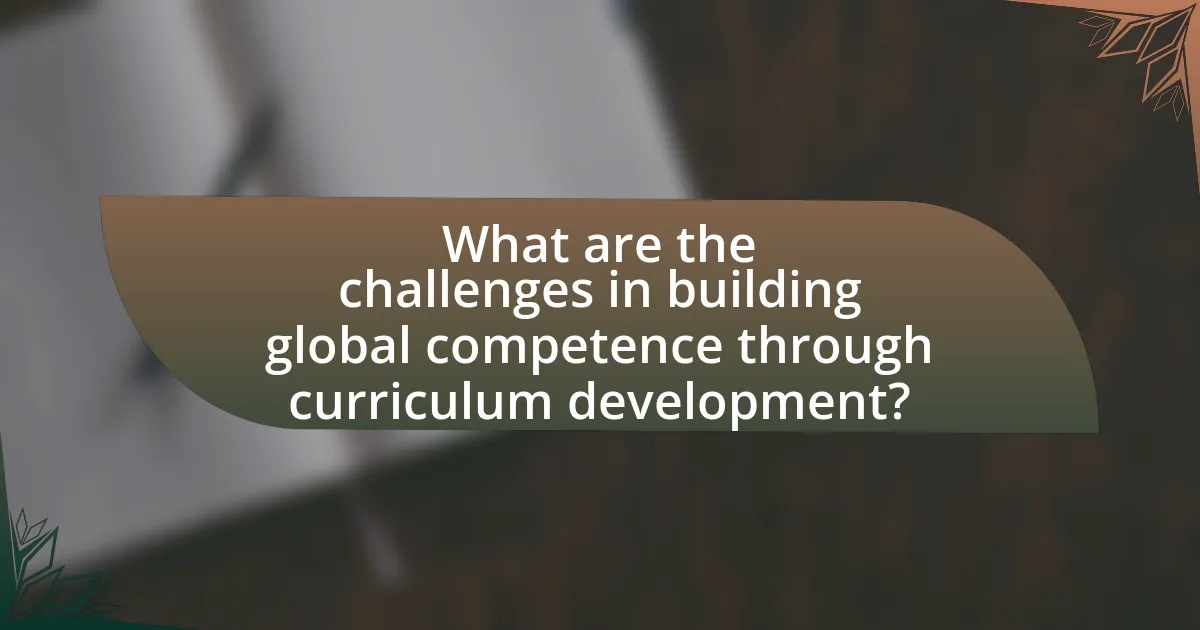Building Global Competence Through Curriculum Development focuses on creating educational programs that equip students with essential skills, knowledge, and attitudes for success in a globalized world. The article outlines how curriculum development enhances global competence by integrating diverse perspectives, fostering critical thinking, and addressing real-world issues. Key elements include the influence of cultural perspectives on curriculum design, the importance of global competence in education, and the essential skills required for students. Additionally, it discusses challenges in curriculum development, strategies for overcoming these challenges, and the role of technology in facilitating global learning experiences. The article emphasizes best practices for implementing effective curricula and aligning assessment methods with global competence goals.

What is Building Global Competence Through Curriculum Development?
Building Global Competence Through Curriculum Development refers to the process of designing educational programs that equip students with the skills, knowledge, and attitudes necessary to thrive in a globalized world. This approach emphasizes the integration of diverse perspectives, cultural awareness, and critical thinking into the curriculum, enabling learners to engage effectively with complex global issues. Research indicates that such curricula can enhance students’ ability to collaborate across cultures, fostering empathy and understanding, which are essential in today’s interconnected society.
How does curriculum development contribute to global competence?
Curriculum development contributes to global competence by integrating diverse perspectives and fostering critical thinking skills essential for navigating a multicultural world. This process involves designing educational programs that emphasize global issues, cultural awareness, and collaborative problem-solving. For instance, the inclusion of international case studies and cross-cultural communication exercises in curricula has been shown to enhance students’ ability to engage effectively in global contexts, as evidenced by research from the Association of American Colleges and Universities, which highlights that students exposed to such curricula demonstrate improved intercultural skills and adaptability.
What are the key elements of curriculum development for global competence?
The key elements of curriculum development for global competence include the integration of diverse perspectives, the emphasis on critical thinking and problem-solving skills, and the incorporation of real-world issues. These elements ensure that learners can understand and engage with global challenges. For instance, integrating diverse perspectives allows students to appreciate cultural differences and develop empathy, while critical thinking equips them to analyze complex global issues. Additionally, addressing real-world problems, such as climate change or social justice, fosters a sense of responsibility and encourages active participation in a global society.
How do cultural perspectives influence curriculum design?
Cultural perspectives significantly influence curriculum design by shaping the content, teaching methods, and assessment strategies used in educational settings. For instance, incorporating diverse cultural viewpoints ensures that the curriculum is relevant and inclusive, fostering a sense of belonging among students from various backgrounds. Research indicates that culturally responsive teaching improves student engagement and academic performance, as it validates students’ identities and experiences. A study by Gay (2010) in “Culturally Responsive Teaching: Theory, Research, and Practice” highlights that when curricula reflect the cultural contexts of students, it enhances their learning outcomes and promotes equity in education.
Why is global competence important in education?
Global competence is important in education because it equips students with the skills necessary to navigate and contribute to an increasingly interconnected world. This competence fosters critical thinking, cultural awareness, and the ability to collaborate across diverse perspectives, which are essential in addressing global challenges such as climate change, social inequality, and economic instability. Research by the Organisation for Economic Co-operation and Development (OECD) indicates that students with global competence are better prepared for the workforce, as they can effectively communicate and work with individuals from various cultural backgrounds. This preparation is vital for success in a globalized economy, where employers increasingly seek individuals who can operate in multicultural environments.
What skills are essential for global competence?
Essential skills for global competence include critical thinking, communication, collaboration, and cultural awareness. Critical thinking enables individuals to analyze complex global issues and make informed decisions. Effective communication skills are necessary for articulating ideas across diverse cultural contexts. Collaboration fosters teamwork in multicultural environments, enhancing problem-solving capabilities. Cultural awareness allows individuals to understand and respect different perspectives, which is crucial in a globalized world. These skills are supported by educational frameworks that emphasize interdisciplinary learning and real-world applications, preparing learners for effective participation in an interconnected society.
How does global competence impact student outcomes?
Global competence significantly enhances student outcomes by equipping learners with the skills necessary to navigate and succeed in an interconnected world. Students who develop global competence demonstrate improved critical thinking, cultural awareness, and problem-solving abilities, which are essential for collaboration in diverse environments. Research indicates that students with higher levels of global competence are more likely to engage in civic activities and exhibit greater empathy towards others, leading to better social cohesion. For instance, a study by the Asia Society found that students who participated in global education programs showed a 20% increase in their ability to work effectively in teams with individuals from different backgrounds. This evidence underscores the positive correlation between global competence and enhanced academic and social outcomes for students.

What are the challenges in building global competence through curriculum development?
Building global competence through curriculum development faces several challenges, including cultural diversity, resource allocation, and assessment methods. Cultural diversity complicates the integration of global perspectives into curricula, as educators must balance local relevance with international viewpoints. Resource allocation is often insufficient, hindering the development of comprehensive programs that address global issues. Additionally, traditional assessment methods may not effectively measure global competence, leading to difficulties in evaluating student outcomes. These challenges highlight the complexities involved in creating curricula that foster global competence in diverse educational settings.
How can educators overcome these challenges?
Educators can overcome challenges in building global competence through curriculum development by integrating culturally relevant pedagogy and fostering collaborative learning environments. Culturally relevant pedagogy allows educators to connect the curriculum to students’ cultural backgrounds, enhancing engagement and understanding. Collaborative learning environments encourage students to work together across diverse perspectives, promoting critical thinking and empathy. Research indicates that when educators implement these strategies, student achievement and global awareness significantly improve, as evidenced by studies showing that culturally responsive teaching can lead to higher academic performance and increased student motivation.
What strategies can be implemented to enhance curriculum effectiveness?
To enhance curriculum effectiveness, strategies such as integrating real-world applications, utilizing diverse teaching methods, and incorporating continuous assessment can be implemented. Real-world applications, such as project-based learning, allow students to connect theoretical knowledge with practical experiences, thereby increasing engagement and retention. Diverse teaching methods, including collaborative learning and technology integration, cater to different learning styles and promote inclusivity. Continuous assessment, through formative evaluations, provides ongoing feedback that helps educators adjust instruction to meet student needs effectively. Research indicates that these strategies lead to improved student outcomes and higher levels of engagement, as evidenced by studies showing that project-based learning can increase student motivation and achievement by up to 30%.
How can collaboration among educators improve curriculum development?
Collaboration among educators can significantly enhance curriculum development by fostering diverse perspectives and expertise. When educators work together, they can share best practices, resources, and innovative teaching strategies, leading to a more comprehensive and effective curriculum. Research indicates that collaborative curriculum design can improve student engagement and learning outcomes, as it allows for the integration of various subject areas and the incorporation of real-world applications. For instance, a study by the National Education Association found that collaborative efforts among teachers resulted in a 20% increase in student performance in schools that implemented team-based curriculum planning. This collaborative approach not only enriches the curriculum but also promotes a culture of continuous improvement among educators.
What role does technology play in curriculum development for global competence?
Technology plays a crucial role in curriculum development for global competence by facilitating access to diverse resources and enabling collaborative learning experiences. It allows educators to integrate global perspectives into the curriculum through digital platforms, online resources, and communication tools that connect students with peers worldwide. For instance, the use of virtual exchange programs and online collaborative projects fosters intercultural understanding and enhances critical thinking skills. Research by the Partnership for 21st Century Skills highlights that technology integration in education promotes skills essential for global competence, such as communication, collaboration, and problem-solving.
How can digital tools facilitate global learning experiences?
Digital tools facilitate global learning experiences by enabling real-time collaboration and access to diverse resources across geographical boundaries. These tools, such as video conferencing platforms, collaborative software, and online learning management systems, allow students and educators from different countries to engage in joint projects, share knowledge, and participate in discussions. For instance, a study by the International Society for Technology in Education found that 78% of educators reported improved student engagement through the use of digital tools in collaborative learning environments. This access to varied perspectives enhances cultural understanding and prepares learners for a globalized workforce.
What are the best practices for integrating technology into the curriculum?
The best practices for integrating technology into the curriculum include aligning technology use with learning objectives, providing professional development for educators, and ensuring equitable access to technology for all students. Aligning technology with learning objectives ensures that digital tools enhance educational outcomes rather than distract from them. Research by the International Society for Technology in Education (ISTE) emphasizes that effective integration requires ongoing training for teachers, enabling them to utilize technology effectively in their teaching practices. Furthermore, studies show that equitable access to technology, such as providing devices and internet access to underserved communities, is crucial for fostering an inclusive learning environment, as highlighted in the 2020 report by the Pew Research Center, which found that students with access to technology perform better academically.

What are the best practices for implementing a curriculum that fosters global competence?
The best practices for implementing a curriculum that fosters global competence include integrating diverse perspectives, promoting critical thinking, and encouraging collaborative learning. Integrating diverse perspectives involves incorporating global issues and cultural contexts into the curriculum, which helps students understand and appreciate different viewpoints. Promoting critical thinking encourages students to analyze and evaluate information from various sources, fostering a deeper understanding of global challenges. Collaborative learning, through group projects and discussions, allows students to work with peers from different backgrounds, enhancing their communication and teamwork skills. Research by the Asia Society emphasizes that curricula designed with these elements lead to improved global awareness and intercultural skills among students.
How can assessment methods be aligned with global competence goals?
Assessment methods can be aligned with global competence goals by integrating performance-based evaluations that measure students’ ability to apply knowledge in real-world contexts. These methods, such as project-based assessments and collaborative tasks, encourage critical thinking, cultural awareness, and problem-solving skills, which are essential components of global competence. Research indicates that assessments designed to reflect authentic challenges, like those outlined in the OECD’s Framework for Global Competence, effectively gauge students’ readiness to engage in a diverse and interconnected world. By focusing on these competencies, educators can ensure that assessment practices not only evaluate academic knowledge but also foster the skills necessary for global citizenship.
What types of assessments are most effective for measuring global competence?
Performance-based assessments are the most effective for measuring global competence. These assessments require students to apply their knowledge and skills in real-world contexts, demonstrating their ability to navigate diverse cultural situations. Research indicates that performance-based assessments, such as project-based learning, simulations, and collaborative tasks, provide a more accurate reflection of a student’s global competence compared to traditional testing methods. For instance, a study by the Asia Society found that students engaged in project-based assessments showed significant improvements in their intercultural communication skills and critical thinking abilities, essential components of global competence.
How can feedback be utilized to improve curriculum development?
Feedback can be utilized to improve curriculum development by systematically collecting and analyzing input from students, educators, and stakeholders to identify strengths and weaknesses in the curriculum. This process allows for targeted adjustments that enhance learning outcomes and ensure the curriculum remains relevant and effective. For instance, studies have shown that incorporating student feedback leads to a 20% increase in engagement and comprehension when curriculum changes are made based on their suggestions. Additionally, educator feedback can highlight areas where instructional strategies may need refinement, further aligning the curriculum with best practices in teaching and learning.
What resources are available for educators to enhance global competence in their curriculum?
Educators can enhance global competence in their curriculum through various resources, including professional development programs, online courses, and educational frameworks. For instance, organizations like the Asia Society provide a framework for global learning that includes resources and strategies for integrating global competence into K-12 education. Additionally, the Global Competence Certificate offered by the University of California, Los Angeles (UCLA) equips educators with the skills to teach global competence effectively. Research indicates that incorporating global perspectives in education leads to improved critical thinking and cultural awareness among students, as highlighted in the report “Educating for Global Competence: Preparing Our Youth to Engage the World” by the Asia Society and the Council of Chief State School Officers.
What organizations provide support for curriculum development in global competence?
Organizations that provide support for curriculum development in global competence include the Asia Society, the Council of Chief State School Officers (CCSSO), and the Partnership for 21st Century Learning. The Asia Society offers resources and frameworks for integrating global competence into education, while CCSSO provides guidelines and tools for states to enhance global learning in schools. The Partnership for 21st Century Learning emphasizes the importance of global competencies in preparing students for a competitive workforce. These organizations contribute to the development of curricula that foster skills necessary for global citizenship, ensuring that educational institutions can effectively prepare students for an interconnected world.
How can educators access professional development opportunities related to global competence?
Educators can access professional development opportunities related to global competence through various platforms and organizations that specialize in global education. For instance, the Asia Society offers resources and training programs focused on global competence, while the Council of Chief State School Officers provides frameworks and tools for integrating global education into curricula. Additionally, online platforms like Coursera and edX offer courses on global issues and intercultural communication, enabling educators to enhance their skills in this area. These resources are validated by their widespread use in educational institutions and endorsements from educational leaders, ensuring that educators can effectively develop global competence in their teaching practices.
What practical tips can educators use to build global competence through curriculum development?
Educators can build global competence through curriculum development by integrating diverse perspectives and global issues into lesson plans. This approach encourages students to engage with different cultures, viewpoints, and real-world challenges. For instance, incorporating case studies from various countries allows students to analyze and discuss international problems, fostering critical thinking and empathy. Research indicates that curricula emphasizing global themes enhance students’ understanding of interconnectedness, as shown in the study “Global Competence: Preparing Our Youth to Engage the World” by the Asia Society, which highlights the importance of global education in developing informed and active citizens.
